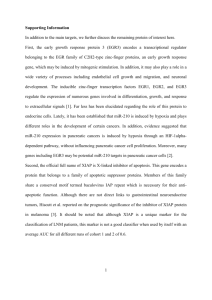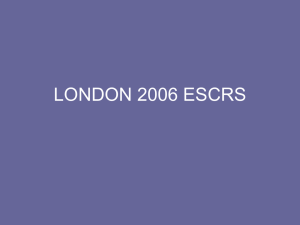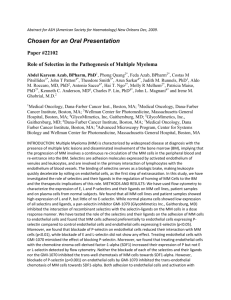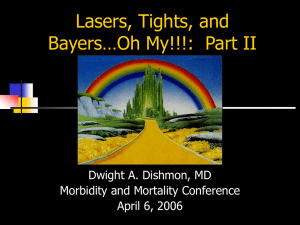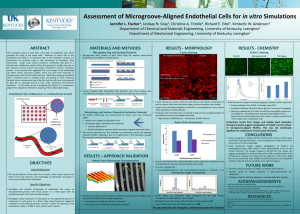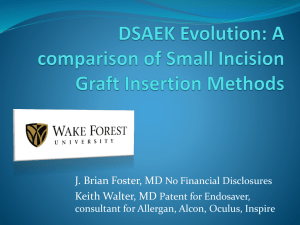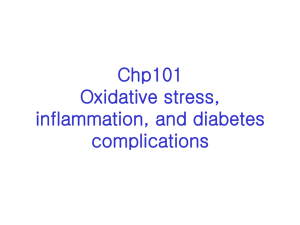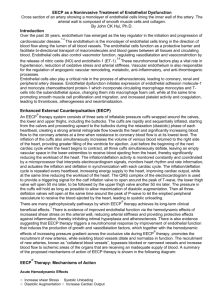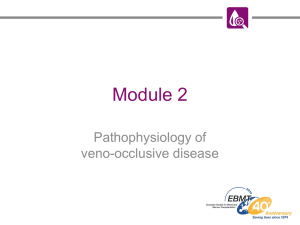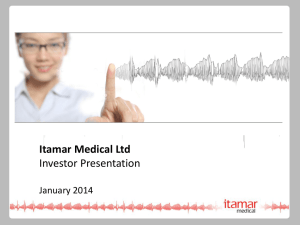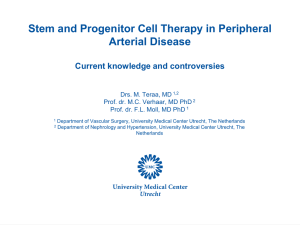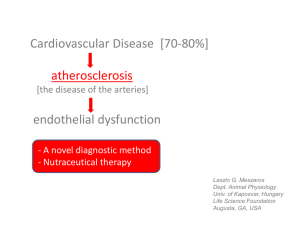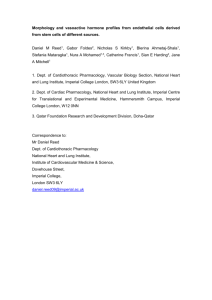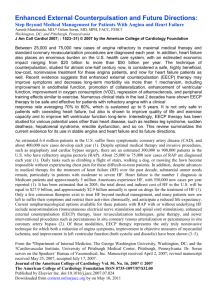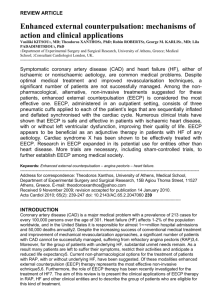EECP Randomized Study - NO Production
advertisement
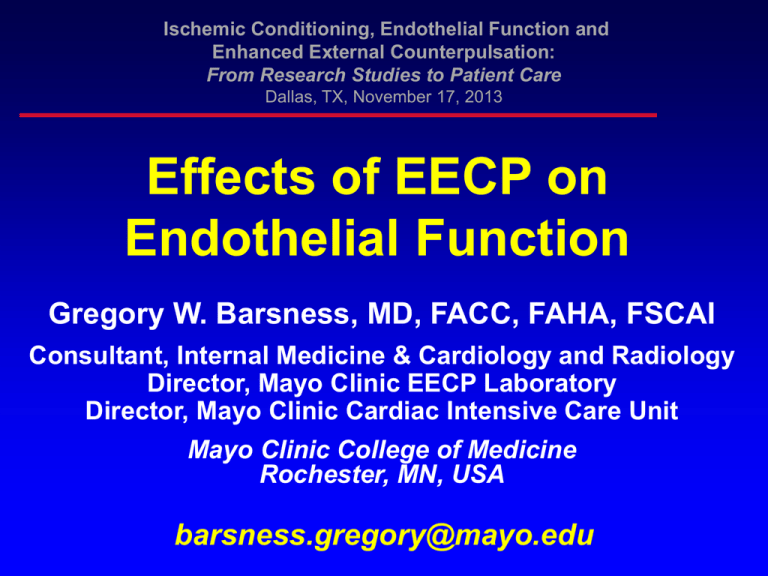
Ischemic Conditioning, Endothelial Function and Enhanced External Counterpulsation: From Research Studies to Patient Care Dallas, TX, November 17, 2013 Effects of EECP on Endothelial Function Gregory W. Barsness, MD, FACC, FAHA, FSCAI Consultant, Internal Medicine & Cardiology and Radiology Director, Mayo Clinic EECP Laboratory Director, Mayo Clinic Cardiac Intensive Care Unit Mayo Clinic College of Medicine Rochester, MN, USA barsness.gregory@mayo.edu “Endothelial Balance” Normal Endothelial Function NO ET-1 PGI2 AngII Vasodilation Atheroprotective NO Function Vasodilatory Antithrombotic Antiproliferative Anti-inflammatory “Endothelial Balance” Normal Endothelial Function Endothelial Dysfunction NO ET-1 PGI2 AngII NO PGI2 ET-1 AngII ↓Endothelial repair Depletion of EPCs Vasodilation Atheroprotective Vasoconstriction Atherogenic Endothelial Dysfunction Relationship to Risk Factors 15 10 5 Slope of 0 Ach dose response -5 relationship (% diameter -10 change/log -15 Ach) -20 -25 -30 r=-0.73 P<0.0001 0 1 2 3 4 5 6 Risk factors (no.) Vita et al: Circ 81:491, 1990 Endothelial Dysfunction and Ischemia 350 300 Coronary blood flow response (%) NS Exercise thallium Normal Abnormal 250 400 300 P<0.005 200 200 P<0.01 150 100 100 50 0 0 CTL AC1 Zeiher, Circulation 1995;91:2345-52. AC2 AC3 PAPA Cardiac Events in Patients with Abnormal Endothelial Function with EndoPAT Cardiac death/MI/ revasc/C hosp (%) 60 Endothelial Dysfunction 40 Normal endothelial function 20 0 0 1 2 3 4 5 6 7 36 55 25 44 Years from EndoPAT study L_RHI <0.4 L_RHI 0.4 129 140 109 123 100 115 83 104 69 86 56 66 Rubinshtein and Lerman, Euro Heart J 2010 Shear Stress is Atheroprotective Shear stress Antithrombotic NO PGI2 tPA Thrombomodulin Antimigration NO Pro-survival Endothelium Antigrowth Low mean shear NO TGF Prothrombotic Smooth muscle Promigration MCP-1 VCAM-1 Pro-apoptosis Endothelium Pro-growth Ang II PDGF Endothelin-1 Atherosclerotic lesion Smooth muscle Traub and Berk, ArterioThromb Vasc Biol 18:677, 1998 External Counterpulsation Suggested Mechanisms of Action Neovascularization Remote Preconditioning Endothelial Function ? ? ? Clinical Benefit ? ? Peripheral Effects ? Passive Exercise? Placebo Effect Doppler Ultrasound of Descending Aorta In aorta (like IABP) • Improved retrograde diastolic and enhanced antegrade systolic flow Improved flow demonstrated in • Renal arteries • Carotid arteries • Internal mammary arteries • Coronary arteries Shear Stress Increases with EECP 13 Hypercholesterolemic Pigs 70 Shear Stress (dynes/cm2) 60 50 40 30 20 10 0 Pre-EECP During EECP Zhang et al, Circulation 2007 Vascular Effects of EECP Shear Stress 140 Improvement of Vascular Health and Gene Expression with EECP 120 Percent 100 Intima/Media Thickness Ratio eNOS Level (% of Control) 80 60 40 20 0 Control(7 Pigs) CHOL(11 Pigs) CHOL+EECP(17 Pigs) Zhang et al, Circulation 2007 Dose-Related NO Increase Endothelin-1 (pg/L) Nitric Oxide (mg/L) ET-1/NO Ratio 250 200 2.5 * 150 2.0 * P<0.01 1.5 100 * 50 * * th on 3M on th 0.5 1M EC P st -E hr Po 24 - hr 12 - r 1h EE CP 0 Pr e- 1.0 * 36 hours of ECP in 13 patients Ahktar et al, AJC 2006 Shear Effect of EECP Plasma Angiotensin II Levels 140 Angiotensin II (pg/ml) Baseline 120 * Post EECP (36 hours) 100 *† 80 60 40 20 0 Controls (n=20) CAD (n=17) * p < 0.05 vs controls; † p <0.05 vs CAD baseline Lawson et al, Eur Heart J 2001;22(Abstr Suppl):538 Peripheral Arterial Tonometry (PAT) Reactive Hyperemia-PAT Protocol Cuff inflation 60 mm > SBP 10 minutes 5 minutes Occlusion Cuff deflation 10 minutes RH-PAT in Patients with Normal and Abnormal Coronary Endothelial Function RH-PAT index (1 minute) 2.5 *p < 0.001 2 1.5 1.8 1 1.2 0.5 0 Normal CEF (n=26) Abnormal CEF (n=19) PAT Reactive Hyperemia p=0.006 RH-PAT index (1 minute) 2.5 p<0.001 2 1.5 1.2 1 0.5 0 Day1 Day17 Pre-EECP Bonetti, Barsness et al, JACC 2003 Post-EECP Day35 EECP Effect on Endothelial Function * p < 0.05 vs. days 1, 17, and 35 1.5 * RH-PAT index 1.29 1 1.04 1.05 1.04 Day 1 Day 17 Day 35 0.5 0 Pre-EECP Bonetti, Barsness et al, JACC 2003 1-month follow-up Clinical Benefit and RH-PAT Index CCS Angina Class * p < 0.05 vs. day 1 RH-PAT index 2 * 1.5 1 1.33 1.02 1.07 1.17 0.5 0 CCS improvement Day 1 Bonetti, Barsness et al, JACC 2003 No CCS improvement 1-month follow-up Clinical Benefit and RH-PAT index Duke Activity Status Index (DASI) * p < 0.05 vs. day 1 RH-PAT index 2 * 1.5 1.32 1 1.00 1.14 1.24 0.5 0 DASI improvement Day 1 Bonetti, Barsness et al, JACC 2003 No DASI improvement 1-month follow-up Circulating Progenitor Cells After EECP Flow Cytometric Analysis (FACS) 100 HPC HPC HPC EPC Cell count/ 100µL Buffy Coat 90 CD34+ CD45dim (p=0.028) CD133+ CD45dim (p=0.034) CD34+ CD133+ CD45 dim(p=0.019) CD34+ CD45 - VEGFR2+ (p=0.17) 80 70 60 50 40 30 20 10 0 Normal CED Baseline Boilson, Kiernan, Barsness, IJC 2011 Day 17 Day 35 (final) 1 month post treatment External Counterpulsation LV Diastolic Filling Parameters (RNA) Time to Peak Filling Rate 4 250 p<0.05 p<0.01 200 3 msec End-Diastolic Volume/sec Peak Filling Rate (n=12) 2 1 150 100 50 0 0 Before After Before After Urano et al, JACC 2001 Interventions that Improve Endothelial Function and Clinical Outcome Lipid-Lowering ACE Inhibitors/ARBs Calcium Channel Blockers N-3 Fatty Acids Glycemic Control in Diabetes Blood Pressure Lowering Smoking Cessation Weight Reduction Exercise PDE-5 Inhibitors EECP The Bottom Line Optimal medical therapy and risk factor modification are essential to improve endothelial function and outcome EECP provides safe, effective, durable symptom relief and is associated with: Improved QoL and vascular health Potential pathway to improve prognosis via plaque modification, vascular function and myocardial performance effects (improved systolic and diastolic functional parameters)
